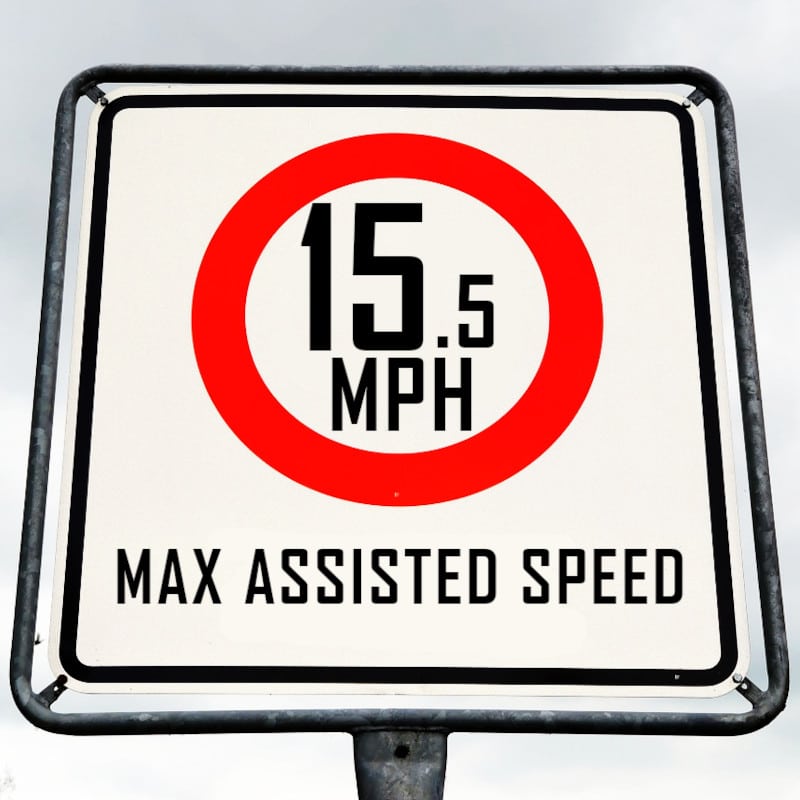Ebike speed limits seem to be a source of eternal debate. In some recent discussions I’ve had with ebike riders, it is generally a consensus that the limit on powered speed is too low. Most stress that limiting speed is a good idea, mainly for safety reasons, but that a few more miles per hour would enhance their enjoyment of using their ebike.
How Fast Can an Ebike Go?
Present legislation in the UK and the EU permits you to fly along no faster, under power, than 25 kilometres per hour, or 15.5 miles per hour.
“In the UK, e-bikes are technically restricted to a speed of 25 kilometres per hour with a battery limit of 250 Watts. If the e-bike has a higher speed unassisted by pedalling, it’s classed as a motor vehicle that requires tax, a licence and insurance.”
(source)
In the USA, they have a set of different classifications depending on the ability of the ebike. Class 1 and Class 2, maximum assisted speed is 20 mph. A Class 3 pedal assist maximum is 28 mph. Not all US States adhere to these classes, so please check what applies locally to you if you reside in the US.
“Class 1: pedal assist only; maximum assisted speed 20 mph. Class 2: throttle assist only; maximum motor-powered speed 20 mph. Class 1 and Class 2 are regulated like bicycles. Class 3: pedal assist only; maximum assisted speed 28 mph. For this class additional rules apply on use and equipment.
(source)
Essentially, in most parts of the world, you have an upper speed limit of between 15.5 mph and 28 mph depending on where you are located. There are calls in some parts of the world for that limit to be increased, for example, petitions in the UK to increase the maximum speed limit to 20 mph.
“It’s commonly accepted in the cycling community that the current limit reduces the likelihood that people will swap their car for an electric bike and that the speed difference being so much lower than a car increases the danger presented to cyclists when sharing the road.
“Additionally, there are a large number of bikes in the UK that have bypassed or do not conform to the current legislation. Increasing it would prevent much faster bicycles from making their way onto the roads and paths.”
(source)
See also: Ebike Classes, the Law and Ebikes
And: The World of Ebikes – Questions and Answers
How Fast is 15.5 mph?
The main reason quoted for the UK and EU speed limit of 15.5 mph is safety. The reasons behind this are obvious. An ebike rider has little protection, compared to a car driver, if they are in a collision. It would be undesirable to have ebikes careering along roads competing with heavy traffic at maximum road speed limits perhaps, but a few mph faster may be of a safety benefit to both the ebike rider and road traffic user. It is a debate that is ongoing, and whether it will eventually change legislation to enable a higher speed limit, we will wait and see, but currently, in the UK and EU, we will have to get used to the 15.5 mph limit, like it or not.
What is 15.5 mph?
If point B is 15.5 miles distant from point A, then you can arrive at point B one hour after leaving point A, travelling at 15.5 mph. That may be stating the obvious, but many people tend to be inaccurate when estimating the distance between two points, and it can be surprising if you point them to google maps or some navigation website to work out the actual distance to a destination. This can be a major factor of consideration before someone takes the leap to commute by ebike rather than car. Length of journey, and time to get there is essential knowledge.

Speed Comparisons
Of course, an ebike limited to a maximum speed of 15.5 mph is not totally accurate. That is the maximum speed that the motor will assist you. Once that speed is reached the motor will cut out and you will increase speed only with the assistance of your legs and pedal power.
Average walking speed is 3 to 4 mph
Average cycling (unpowered) speed is around 10 to 12 mph
If you look at those stats, then you can deduce that using an ebike is over 3 times faster than walking and a little faster than using a traditional unpowered bicycle. The physical effort though, is a lot less work, or energy expended, to get there.
In most urban streets in the UK, the maximum speed limit is 30 mph, though in some areas this is reduced to 20 mph.
Therefore, on an ebike, you can attain, under power, half the legal road speed, or 75% of the legal road limit in a 20 mph area.
Without starting a debate around separate ebike lanes, and considering a great proportion of ebike riders will be sharing road space with traffic, heavy at times, consisting of cars, vans, buses and trucks, reaching even the maximum powered limit of a legal ebike may be hard to attain at some points of the journey. It is a debate that will no doubt continue as to whether a slight increase in maximum powered speed will benefit ebike riders. Personally, I would welcome an increase to around 20 mph, perhaps with limiters that could be adjusted lower by the rider for their own preference, if desired.
With the constant advance of technology, and with separate bicycle and ebike lanes becoming a priority in most local government planning departments, it may only be a matter of time before ebike legislation regarding maximum assisted speed is looked at again, in detail, to consider if it is fit for purpose.
Until then, bask in the knowledge that 15 mph is very fast for a runner (equating to a 4-minute mile), and even Usain Bolt can hit a maximum of 28 mph. Runners, though, can only maintain these speeds for short periods. You can zoom along on your ebike with far less effort for much longer, to go a far greater distance.

